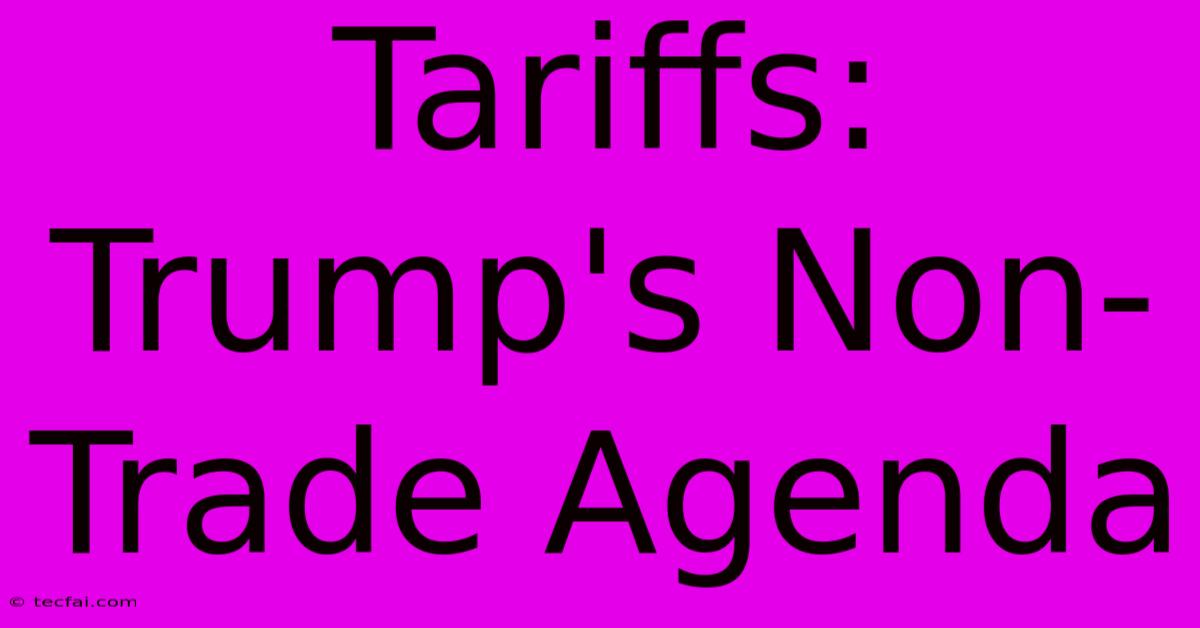Tariffs: Trump's Non-Trade Agenda

Discover more detailed and exciting information on our website. Click the link below to start your adventure: Visit Best Website tecfai.com. Don't miss out!
Table of Contents
Tariffs: Trump's Non-Trade Agenda
Donald Trump's presidency was punctuated by a dramatic increase in tariffs, impacting global trade relations and sparking significant debate. While often framed as a tool to protect American industries and renegotiate trade deals, a deeper analysis reveals a multifaceted agenda extending beyond traditional trade policy. This article explores the complexities of Trump's tariff strategy, examining its motivations beyond simple economic gains and its lasting consequences.
Beyond the Balance Sheet: The Political Calculus of Tariffs
Trump's use of tariffs wasn't solely about economics; it was a potent political tool. His administration leveraged tariffs to:
1. Fulfill Campaign Promises: A core promise of Trump's campaign was to challenge established trade relationships that he perceived as unfair to American workers. Imposing tariffs, particularly on China, served as a visible demonstration of fulfilling this promise to his base. This resonated strongly with voters who felt neglected by globalization and traditional trade agreements.
2. Demonstrate Strength and Nationalism: The imposition of tariffs projected an image of American strength and resolve on the global stage. By engaging in trade wars, Trump aimed to portray the US as a powerful nation unwilling to accept unfavorable trade practices. This appealed to a nationalist sentiment prevalent within his support base.
3. Distract from Domestic Issues: The imposition of tariffs, with its inherent complexities and media attention, could serve as a distraction from other potentially damaging domestic issues. By focusing public attention on trade disputes, the administration could shift the narrative away from less favorable developments.
The Economic Realities: Winners and Losers
While the political motivations were significant, the economic consequences of Trump's tariffs were far-reaching and complex.
Winners: Certain domestic industries, particularly those directly competing with imported goods, experienced a short-term boost. This included some sectors of steel and aluminum production, benefiting from reduced foreign competition. However, this benefit often came at a considerable cost.
Losers: Many American businesses, particularly those reliant on imported components or exporting goods, faced significant increased costs and reduced competitiveness. Consumers ultimately bore the brunt of increased prices due to tariffs on imported goods, impacting their purchasing power. Farmers, a key constituency often touted as beneficiaries of protectionist measures, frequently suffered as a result of retaliatory tariffs imposed by other countries.
Long-Term Impacts and Unintended Consequences
The long-term effects of Trump's tariff policies are still unfolding. However, some significant consequences are already evident:
- Supply Chain Disruptions: The imposition of tariffs led to disruptions in global supply chains, making it more expensive and difficult for businesses to obtain necessary components and materials.
- Increased Inflation: Tariffs contributed to increased prices for consumers, exacerbating inflationary pressures.
- Retaliatory Tariffs: Other countries responded with their own retaliatory tariffs, creating a cycle of trade restrictions that hurt both domestic and global economies.
- Damaged International Relations: Trump's aggressive use of tariffs strained relationships with key trading partners, impacting broader diplomatic and strategic alliances.
Conclusion: A Legacy of Complexity
Trump's tariff strategy was far more than a simple economic policy. It was a complex interplay of political maneuvering, economic calculation, and nationalist sentiment. While it achieved some short-term gains for certain sectors, the long-term consequences, including supply chain disruptions, increased prices, and damaged international relations, raise significant concerns. Understanding this multifaceted agenda is crucial to analyzing its impact and informing future trade policies. The lasting legacy of Trump's tariffs remains a subject of ongoing debate and research among economists and political scientists alike.

Thank you for visiting our website wich cover about Tariffs: Trump's Non-Trade Agenda. We hope the information provided has been useful to you. Feel free to contact us if you have any questions or need further assistance. See you next time and dont miss to bookmark.
Featured Posts
-
Morrisons Shoppers Face Empty Shelves
Nov 27, 2024
-
Bernardo Remains Imprisoned Parole Denied After Victim Impact
Nov 27, 2024
-
Rag N Bone Man Summer Series Show
Nov 27, 2024
-
Paul Bernardo Parole Rejected Again
Nov 27, 2024
-
2025 Uk Extra Bank Holiday Dates
Nov 27, 2024
